Okt . 22, 2024 05:21 Back to list
Counterweighted Check Valve for Enhanced Performance and Reliability in Fluid Systems
The Importance of Check Valves with Counterweights in Industrial Applications
Check valves are crucial components in various industrial systems, especially in fluid transport and management. Their primary function is to allow fluid to flow in one direction while preventing backflow. Among the various types of check valves available, those equipped with counterweights stand out due to their enhanced efficiency and reliability. This article delves into the mechanics, benefits, applications, and maintenance considerations related to check valves with counterweights.
Mechanics of Check Valves with Counterweights
A check valve is designed to open in response to fluid flowing in the intended direction, with the valve disc or ball resting on a seat to prevent backflow when the flow stops or reverses. In a check valve with a counterweight, the valve disc is aided by a counterweight mechanism that enhances its operational capabilities. This counterweight is generally attached to the valve disc itself or integrated within the structure of the valve.
When the fluid pressure exceeds a certain threshold, the counterweight aids in lifting the valve disc, allowing fluid to flow through. Once the flow decreases or reverses, the counterweight helps to ensure that the valve closes swiftly and firmly, thus minimizing the risk of backflow. The integration of a counterweight can also reduce the wear on the valve seat and mechanical components, leading to a longer service life.
Benefits of Check Valves with Counterweights
1. Enhanced Reliability The combination of fluid dynamics and the counterweight mechanism results in reliable closure, significantly reducing the chances of leakage or backflow. This reliability is critical in preventing potential damage to pumps and other equipment downstream.
2. Reduced Water Hammer Effects One of the common issues in fluid systems is the water hammer effect, which occurs when there is a sudden change in water flow. The counterweight helps moderate the closure speed of the valve, thereby dampening the impact of fluid surges and reducing the risk of damage to pipes and valves.
3. Operational Efficiency By providing a smoother transition from open to closed positions, check valves with counterweights can improve overall system efficiency. This efficiency is particularly advantageous in applications where constant flow rates are essential.
4. Lower Maintenance Requirements The clever design and reduced wear of the components allow for less frequent maintenance and replacement. This translates into cost savings and unplanned downtime reductions, making them an economically favorable choice in the long run.
Applications in Various Industries
check valve with counterweight

Check valves with counterweights are utilized across a variety of industries to ensure safe and efficient fluid handling
- Water and Wastewater Management In municipal water systems, these valves prevent backflow that could lead to contamination and ensure a consistent water supply. They are also crucial in wastewater treatment plants to maintain proper flow direction.
- Oil and Gas In the oil and gas sector, managing fluid flow through pipelines is essential for operational safety. Check valves with counterweights help prevent backflow that could damage pumps and compressors, ensuring a smooth operation.
- Chemical Processing The chemical industry often deals with corrosive or hazardous materials. The enhanced reliability of check valves with counterweights helps maintain the integrity of processing systems and safeguard against leaks.
- HVAC Systems In heating, ventilation, and air conditioning systems, these valves prevent backflow of air or fluids, enhancing system efficiency and indoor air quality.
Maintenance Considerations
While check valves with counterweights are designed for longevity, regular maintenance is still essential to ensure their optimal function. Users should conduct periodic inspections to check for signs of wear, corrosion, or buildup of debris that could impede valve operation. Lubrication of moving parts and proper alignment of the counterweight mechanism is also crucial for maintaining efficiency.
Additionally, any unusual noises during operation, such as banging or rattling, should be investigated immediately, as these could indicate mechanical issues. A well-maintained check valve can offer years of reliable service, safeguarding system integrity and efficiency.
Conclusion
Check valves with counterweights offer significant advantages in fluid control applications, enhancing reliability, operational efficiency, and maintenance ease. Their invaluable role across various industries underscores the importance of selecting the right valve for specific applications. By understanding their mechanics and benefits, industrial managers can make informed decisions that bolster their fluid management systems and ensure long-term performance.
Share
-
Reliable Wafer Type Butterfly Valves for Every IndustryNewsJul.25,2025
-
Reliable Flow Control Begins with the Right Ball Check ValveNewsJul.25,2025
-
Precision Flow Control Starts with Quality ValvesNewsJul.25,2025
-
Industrial Flow Control ReliabilityNewsJul.25,2025
-
Engineered for Efficiency Gate Valves That Power Industrial PerformanceNewsJul.25,2025
-
Empowering Infrastructure Through Quality ManufacturingNewsJul.25,2025